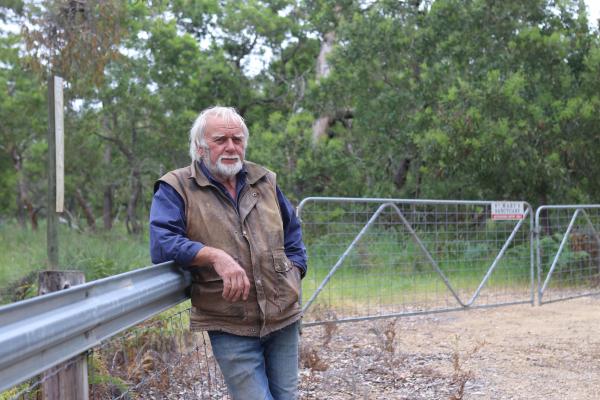
By Molly Taylor
A LARGELY untouched ecosystem near Penola has undergone extensive weed removal to help maintain its native vegetation and wildlife and reduce environmental threats.
Spanning roughly 300 acres, St Mary’s Sanctuary is a pristine area filled with native vegetation and is considered a high-priority feeding habitat to the endangered South-eastern Red-tailed Black-Cockatoo.
Due to its significance, volunteer conservation group Trees For Life has worked to remove woody weeds at the site to improve productivity and reduce degradation of habitat from weed invasion.
A team of eight contractors spent around two weeks to treat all weeds within a 100-hectare block and a follow-up visit is scheduled in 12-months time.
The two rounds of treatment were estimated to cost around $20,000.
Trees For Life South‑eastern Red‑tailed Black‑Cockatoo habitat officer Cassie Hlava said the sanctuary was particularly important as it contained a remnant patch of brown stringy bark woodland.
“Brown stringybark is one of only three food species of the endangered South-Eastern Red-Tailed Black-Cockatoo. These beautiful birds are regular visitors to the sanctuary,” Ms Hlava said.
“Since 1947, 73pc of stringybark habitat has been lost in the South East of South Australia, therefore all remnant patches of this habitat are important.
“The sanctuary also conserves red gum, manna gum and blue gum woodland and provides habitat for a large diversity of woodland birds including the black-chinned honeyeater which is vulnerable in South Australia.”
In spring, a myriad of orchids can also be seen at the property, including spider orchids, pink fingers, donkey orchids and purple cockatoo.
The main weeds investing the sanctuary include Boneseed (Chrysanthemoides monilifera), Coastal wattle (Acacia longifolia ssp sophorae) and sallow wattle (Acacia longifolia ssp longifolia).
“Boneseed is declared a weed from South Africa with bright yellow flowers. Emus and foxes spread the round hard seeds which readily germinate and rapidly spread across large areas of bushland,” Ms Hlava said.
“Coastal wattle and sallow wattle are two similar looking wattle species which grow into large shrubs and form dense thickets.”
Radiata Pine (Pinus radiate) was also being terminated at other sites, which often establishes in bushland next to commercial pine plantations.
Ms Hlava said all listed weeds compete with native plants for space, light, nutrients and water.
“If left unchecked they eventually dominate the bushland, crowding out small groundcover species,” she said.
“They change the mid-storey structure, and make the woodland much more dense and difficult to walk through, this can make it uninhabitable for many wildlife species and can also increase the bushfire risk.
“The impacts of woody weeds on red-tailed black cockatoos can be significant as large dense infestations reduce the amount of seed produced by the brown stringybark trees and limits regeneration of stringybark seedlings.”
St Mary’s Wines and Spirits shares it property with the sanctuary, with owner Barry Mulligan – who helps care for the area – stating the area had been locked-up since his grandfather purchased it in 1937.
Since taking ownership of the estate, Mr Mulligan said he made the decision to maintain and preserve the sanctuary.
“I can always remember it as a kid and have this memory of black cockatoos flying over the top when down there with my father,” he said.
“The site offers all different land forms including Terra Rossa ridges, which run pretty much all the way through and you can see what land looked before it was cleared.
“As I understand, the sanctuary is the only singular patches of land in the region which is relatively unaffected by European land management.”
Mr Mulligan said he had never regretted maintaining the site.
“When family members come back from wherever they’ve been in the world, they’ll disappear and that’s where they’ll go,” he said.
“It is a microcosm of all the different land forms in the district and I don’t think anybody else has that, you can see all the flora and fauna go through and utilise it.
“The interesting thing is a lot of the birds which were catalogued in 1982 can be listed again today.”
A family home neighbouring the sanctuary boundary is routinely graced with the presence of South-eastern Red-tailed Black-Cockatoos, with one night reportedly attracting a total of 84.
Mr Mulligan has committed to continue with follow-up control measures in the future to ensure the weed problem does not come back.
This work is being completed as part of the Communities helping Cockies project, a five-year project supported by the Limestone Coast Landscape Board through funding from the Australian Government’s National Landcare Program.
It is delivered in partnership with Birdlife Australia, Zoos SA and Trees For Life.
The project has been operational for two years.
Trees for Life has so far mapped and removed woody weeds from 600 hectares of south-eastern red-tailed black-cockatoo stringybark feeding habitat across four properties.









